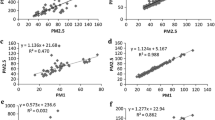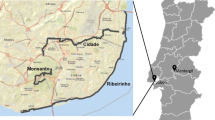Abstract
An indoor/outdoor monitoring programme of PM10 was carried out in two sports venues (a fronton and a gymnasium). Levels always below 50 μg m−3 were obtained in the fronton and outdoor air. Due to the climbing chalk and the constant process of resuspension, concentrations above 150 μg m−3 were registered in the gymnasium. The chalk dust contributed to CO3 2− concentrations of 32 ± 9.4 μg m−3 in this sports facility, which represented, on average, 18 % of the PM10 mass. Here, the carbonate levels were 128 times higher than those registered outdoors. Much lower concentrations, around 1 μg m−3, were measured in the fronton. The chalk dust is also responsible for the high Mg2+ concentrations in the gym (4.7 ± 0.89 μg m−3), unfolding a PM10 mass fraction of 2.7 %. Total carbon accounted for almost 30 % of PM10 in both indoor spaces. Aerosol size distributions were bimodal and revealed a clear dependence on physical activities and characteristics of the sports facilities. The use of climbing chalk in the gymnasium contributed significantly to the coarse mode. The average geometric mean diameter, geometric standard deviation and total number of coarse particles were 0.77 μm, 2.79 cm−3 and 28 cm−3, respectively.







Similar content being viewed by others
Abbreviations
- EC:
-
Elemental carbon
- EDS:
-
Energy dispersive X-ray spectrometer
- FE-SEM:
-
Field emission scanning electron microscopy
- GMD:
-
Geometric mean diameter
- IAQ:
-
Indoor air quality
- OC:
-
Organic carbon
- PC:
-
Pyrolysed organic carbon
- PCASP:
-
Passive cavity aerosol spectrometer probe
- PM:
-
Particulate matter
- TC:
-
Total carbon
- VOCs:
-
Volatile organic compounds
References
Alados-Arboledas L, Lyamani H, Olmo FJ (2003) Aerosol size properties at Armilla, Granada (Spain). Q J Roy Meteor Soc 129:1395–1413
Almeida SM, Canha N, Silva A, Freitas MC, Pegas P, Alves C, Evtyugina M, Pio C (2011) Children exposure to air particulate matter in indoor of Lisbon primary schools. Atmos Environ 45:7594–7599
Alves CA, Calvo AI, Castro A, Fraile R, Evtyugina M, Bate-Epey EF (2013a) Indoor air quality in two university sports facilities. Aerosol Air Qual Res 13:1723–1730
Alves C, Nunes T, Silva J, Duarte M (2013b) Comfort parameters and particulate matter (PM10 and PM2.5) in school classrooms and outdoor air. Aerosol Air Qual Res 13:1521–1535
Bartley DL, Vicent JH (2011) Sampling conventions for estimating ultrafine and fine aerosol particle deposition in the human respiratory tract. Ann Occup Hyg 55:696–709
Batterman S, Du L, Mentz G, Mukherjee B, Parker E, Godwin C, Chin JY, O’Toole A, Robins T, Rowe Z, Lewis T (2012) Particulate matter concentrations in residences: an intervention study evaluating stand-alone filters and air conditioners. Indoor Air 22:235–252
Bohren CF, Huffman DR (1983) Absorption and scattering of light by small particles. Wiley, New York
Braniš M, Šafránek J, Hytychová A (2009) Exposure of children to airborne particulate matter of different size fractions during indoor physical education at school. Build Environ 44:1246–1252
Braniš M, Šafránek J (2011) Characterization of coarse particulate matter in school gyms. Environ Res 111:485–491
Braniš M, Safránek J, Hytychova A (2011) Indoor and outdoor sources of size-resolved mass concentrations of particulate matter in a school gym—implications for exposure of exercising children. Environ Sci Pollut R 18:598–609
Buonanno G, Fuoco FC, Marini S, Stabile L (2012) Particle resuspension in school gyms during physical activities. Aerosol Air Qual Res 12:803–813
Calvo AI, Pont V, Castro A, Mallet M, Palencia C, Roger JC, Dubuisson P, Fraile R (2010) Radiative forcing of haze during a forest fire in Spain. J Geophys Res 115, D08206
Cambra-López M, Aarnink AJA, Zhao Y, Calvet S, Torres AG (2010) Airborne particulate matter from livestock production systems: a review of an air pollution problem. Environ Pollut 158:1–17
Carlisle A, Sharp N (2001) Exercise and outdoor ambient air pollution. Brit J Sport Med 35:214–222
Donaldson K, Stone V, Gilmour PS, Brown DM, MacNee W (2000) Ultrafine particles: mechanisms of lung injury. Philos T Roy Soc A 358:2741–2748
Guo H, Kwok NH, Cheng HR, Lee SC, Hung WT, Li YS (2009) Formaldehyde and volatile organic compounds in Hong Kong homes: concentrations and impact factors. Indoor Air 19:206–217
Guo H, Lee SC, Chan LY (2004) Indoor air quality in ice skating rinks in Hong Kong. Environ Res 94:327–335
Hasan H, Dzubay TG (1983) Apportioning light extinction coefficients to chemical-species in atmospheric aerosol. Atmos Environ 17:1573–1581
Hong Kong Special Administrative Region (HKSAR) (2003) Guidance notes for the management of indoor air quality in offices and public Places. Indoor Air Quality Management Group. The Government of the Hong Kong Special Administrative Region. http://www.iaq.gov.hk/cert/doc/GN-eng.pdf. Accessed May 2014
Horvath H (1998) Influence of atmospheric aerosols upon the global radiation balance. In: Harrison RM, Van Grieken R (eds) Atmospheric particles IUPAC series on analytical and physical chemistry of environmental systems, vol 5. Wiley, New York, pp 543–596
Huang H, Cao JJ, Lee SC, Zou CW, Chen XG, Fan SJ (2007) Spatial variation and relationship of indoor/outdoor PM2.5 at residential homes in Guangzhou city, China. Aerosol Air Qual Res 7:518–530
Jia C, Batterman S, Godwin C, Charles S, Chin JY (2010) Sources and migration of volatile organic compounds in mixed-use buildings. Indoor Air 20:357–369
Kreyling WG, Semmler-Behnke M, Moller W (2006) Ultrafine particle-lung interactions: Does size matter? J Aerosol Med 19:74–83
Levin EJT, McMeeking GR, Carrico C, Mack L, Kreidenweis SM, Wold CE, Moosmüller H, Arnott WP, Hao WM, Collett JL, Malm WC (2010) Biomass burning smoke aerosol properties measured during FLAME. J Geophys Res 115:D18
Lin ZJ, Tao J, Chai FH, Fan SJ, Yue JH, Zhu LH (2012) Impact of relative humidity and particles size distribution on aerosol light extinction in urban area of Guangzhou. Atmos Chem Phys Discuss 12:15639–15674
Majumdar D, William SPM (2009) Chalk dustfall during classroom teaching: particle size distribution and morphological characteristics. Environ Monit Assess 148:343–335
McCormack MC, Breysse PN, Hansel NN, Matsui EC, Tonorezos ES, Curtin-Brosnan J, Williams DL, Buckley TJ, Eggleston PA, Diette GB (2008) Common household activities are associated with elevated particulate matter concentrations in bedrooms of inner-city Baltimore pre-school children. Environ Res 106:148–155
Molinié J, Clotaire V, Plocoste R, Petit H (2011) Night outdoor air as a major source of indoor air particle concentrations in an office. In: Proceedings of the 91st American Meteorological Society, Washington, USA
Morawska L, Keogh DU, Thomas SB, Mengersen KL (2008) Modality in ambient particle size distributions and its potential as a basis for developing air quality regulation. Atmos Environ 42:1617–1628
Ortega IK, Suni T, Boy M, Grönholm T, Manninen HE, Nieminen T, Ehn M, Junninen H, Hakola H, Hellén H, Valmari T, Arvela H, Zegelin S, Hughe D, Kitchen M, Cleugh H, Worsnop DR, Kulmala M, Kerminen VM (2012) New insights into nocturnal nucleation. Atmos Chem Phys 12:4297–4312
Paintal HS, Kuschner WG (2010) Indoor sports. In: Tarlo SM, Cullinan P, Nemer B (eds) Occupational and environmental lung diseases. Wiley, Chichester, pp 137–157
Pegas PN, Nunes T, Alves CA, Silva JR, Vieira SLA, Caseiro A, Pio C (2012) Indoor and outdoor characterisation of organic and inorganic compounds in city centre and suburban elementary schools of Aveiro, Portugal. Atmos Environ 55:80–89
Perry RH, Green DW, Maloney JO (1997) Perry’s chemical engineers’ handbook, 7th edn. McGraw-Hill, New York
Rundell KW (2003) High levels of airborne ultrafine and fine particulate matter in indoor ice arenas. Inhal Toxicol 15:237–250
Saldiva PHN, Clarke RW, Coull BA, Stearns RC, Lawrence J, Murthy GGK, Diaz E, Koutrakis P, Suh H, Tsuda A, Godleski JJ (2002) Lung inflammation induced by concentrated ambient air particles is related to particle composition. Am J Resp Crit Care 165:1610–1617
Salonen HJ, Pasanen AL, Lappalainen SK, Riuttala HM, Tuomi TM, Pasanen PO, Bäck BC, Reijula KE (2009) Airborne concentrations of volatile organic compounds, formaldehyde and ammonia in Finnish office buildings with suspected indoor air problems. J Occup Environ Hyg 6:200–209
Salonen RO, Pennanen AS, Vahteristo M, Korkeila P, Alm S, Randell JT (2008) Health risk assessment of indoor air pollution in Finnish ice arenas. Environ Int 34:51–57
Sangiorgi G, Ferrero L, Ferrini BS, Lo Porto C, Perrone MG, Zangrando R, Gambaro A, Lazzati Z, Bolzacchini E (2013) Indoor airborne particle sources and semi-volatile partitioning effect of outdoor fine PM in offices. Atmos Environ 65:205–214
Semple S, Garden C, Coggins M, Galea KS, Whelan P, Cowie H, Sánchez-Jiménez A, Thorne PS, Hurley JF, Ayres JG (2012) Contribution of solid fuel, gas combustion, or tobacco smoke to indoor air pollutant concentrations in Irish and Scottish homes. Indoor Air 22:212–223
Skoog D, West D, Holler F (1996) Fundamentals of analytical chemistry, 7th edn. Saunders, USA
Stranger M, Potgieter-Vermaak SS, van Grieken R (2007) Comparative overview of indoor air quality in Antwerp, Belgium. Environ Int 33:789–797
Stranger M, Potgieter-Vermaakand SS, van Grieken R (2008) Characterization of indoor air quality in primary schools in Antwerp, Belgium. Indoor Air 18:454–463
Tang T, Hurraß J, Gminski R, Mersch-Sundermann V (2012) Fine and ultrafine particles emitted from laser printers as indoor air contaminants in German offices. Environ Sci Pollut R 19:3840–3849
Tang IN (1996) Chemical and size effects of hygroscopic aerosols on light scattering coefficients. J Geophys Res 101:19250
Texas Department of State Health Services (TDSHS) (2014). Texas voluntary indoor air quality guidelines for government buildings. Division of Regulatory Services. Austin, TX. Publication # 2–10, Jan. 2003. Updated Feb. 2014. https://www.dshs.state.tx.us/iaq/SchoolsGuide.shtm. Accessed May 2014
Weinbruch S, Dirsch T, Ebert M, Hofmann H, Kandler K (2008) Dust exposure in indoor climbing halls. J Environ Monit 10:648–654
Weinbruch S, Dirsch T, Kandler K, Ebert M, Heimburger G, Hohenwarter F (2012) Reducing dust exposure in indoor climbing gyms. J Environ Monit 14:2114–2120
World Health Organization (WHO) (2010) WHO guidelines for indoor air quality: selected pollutants. WHO Regional Office for Europe, Bonn Office
Acknowledgments
This study was partially funded by the Centre of Environmental and Marine Studies (CESAM) of the University of Aveiro (PEst-C/MAR/LA0017/2013) and by the Spanish Ministry of Science and Innovation (Grant TEC2010-19241-C02-01). The electron microscopy analyses were conducted at CNME-UCM through the AEROCLIMA project (Fundación Ramón Areces). Ana Calvo acknowledges the postdoctoral grant SFRH/BPD/64810/2009 from the Portuguese Science Foundation (FCT). We would also like to thank Darrel Baumgardner (Droplet Measurement Technologies, Boulder) for their valuable comments and support on the PCASP data corrections. Thanks to the Faculty of Physical Education and Sports, University of León, for allowing us the access to the sports facilities and also to Guillermo Arias and Elisa Estapé for their kindness and availability.
Author information
Authors and Affiliations
Corresponding author
Additional information
Responsible editor: Constantini Samara
Rights and permissions
About this article
Cite this article
Alves, C., Calvo, A.I., Marques, L. et al. Particulate matter in the indoor and outdoor air of a gymnasium and a fronton. Environ Sci Pollut Res 21, 12390–12402 (2014). https://doi.org/10.1007/s11356-014-3168-1
Received:
Accepted:
Published:
Issue Date:
DOI: https://doi.org/10.1007/s11356-014-3168-1




